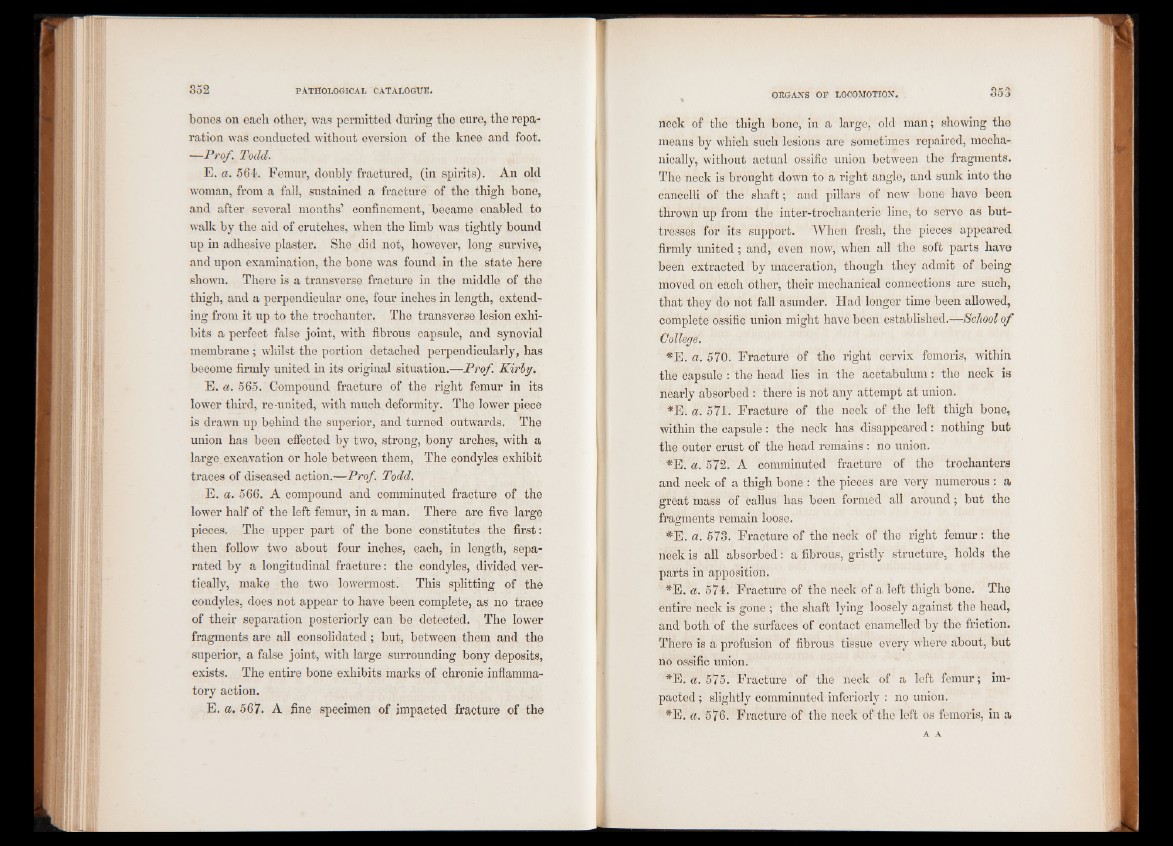
bones on each other, was permitted during the cure, the reparation
was conducted without eversion of the knee and foot.
—Prof. Todd.
E. a. 564. Femur, doubly fractured, (in spirits). An old
woman, from a fall, sustained a fracture of the thigh bone,
and after several months’ confinement, 'became enabled to
walk by the aid of crutches, when the limb was tightly bound
up in adhesive plaster. She did not, however, long survive,
and upon examination, the bone was found in the state here
shown. There is a transverse fracture in the middle of the
thigh, and a perpendicular one, four inches in length, extending
from it up to the trochanter. The transverse lesion exhibits
a perfect false joint, with fibrous capsule, and synovial
membrane ; whilst the portion detached perpendicularly, has
become firmly united in its original situation.—Prof. Kirby.
E. a. 565. Compound fracture of the right femur in its
lower third, re-united, with much deformity. The lower piece
is drawn up behind the superior, and turned outwards. The
union has been effected by two, strong, bony arches, with a
large excavation or hole between them, The condyles exhibit
traces of diseased action.—Prof. Todd.
E. a. 566. A compound and comminuted fracture of the
lower half of the left femur, in a man. There are five large
pieces. The upper part of the bone constitutes the first:
then follow two about four inches, each, in length, separated
by a longitudinal fracture: the condyles, divided vertically,
make the two lowermost. This splitting of the
condyles, does not appear to have been complete, as no trace
of their separation posteriorly can be detected. The lower
fragments are all consolidated; but, between them and the
superior, a false joint, with large surrounding bony deposits,
exists. The entire bone exhibits marks of chronic inflammatory
action.
E. a. 567. A fine specimen of impacted fracture of the
neck of the thigh bone, in a large, old man; showing the
means by which such lesions are sometimes repaired, mechanically,
without actual ossific union between the fragments.
The neck is brought down to a right angle, and sunk into the
cancelli of the shaft; and pillars of new bone have been
thrown up from the inter-trochanteric line, to serve as buttresses
for its support. When fresh, the pieces appeared
firmly united; and, even now, when all the soft parts have
been extracted by maceration, though they admit of being
moved on each other, their mechanical connections are such,
that they do not fall asunder. Had longer time been allowed,
complete ossific union might have been established.—School of
College.
*E. a. 570. Fracture of the right cervix femoris, within
the capsule : the head lies in the acetabulum: the neck is
nearly absorbed : there is not any attempt at union.
*E. a. 571. Fracture of the neck of the left thigh bone,
within the capsule : the neck has disappeared: nothing but
the outer crust of the head remains : no union.
*E. a. 572. A comminuted fracture of the trochanters
and neck of a thigh bone : the pieces are very numerous : a
great mass of callus has been formed all around; but the
fragments remain loose.
#E. a. 573. Fracture of the neck of the right femur: the
neck is all absorbed: a fibrous, gristly structure, holds the
parts in apposition.
*E. a. 574. Fracture of the neck of a left thigh bone. The
entire neck is gone ; the shaft lying loosely against the head,
and both of the surfaces of contact enamelled by the friction.
There is a profusion of fibrous tissue every where about, but
no ossific union.
*E. a. 575. Fracture of the neck of a left femur; impacted
; slightly comminuted interiorly : no union.
*E. a. 576. Fracture of the neck of the left os femoris, in a
A A